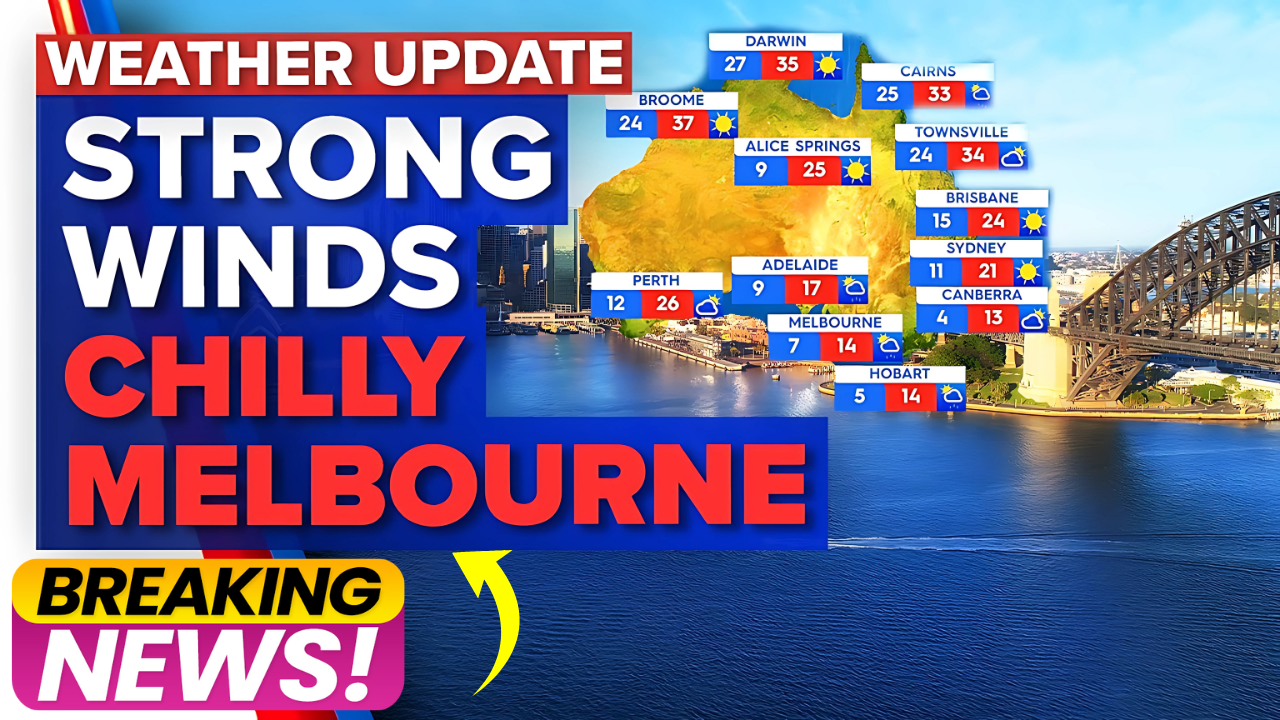Melbourne’s reputation for experiencing “four seasons in one day” isn’t just a local saying—it’s a meteorological reality that residents and visitors experience regularly. The city’s unique geographical position and complex weather systems create some of Australia’s most unpredictable and fascinating climatic conditions. Melbourne weather forecast today cloudy conditions with 95% chance of showers, temperatures 10-14°C, northerly winds shifting southwest.
Current Weather Snapshot for Melbourne
Today’s Melbourne weather presents typical winter characteristics with cloudy skies and a very high chance of showers, particularly during morning hours. Current temperatures are hovering around 11°C with expectations to reach a maximum of 14°C. The atmospheric pressure sits at a stable 1013.6 hPa, while humidity levels maintain around 55%, creating moderately comfortable conditions despite the cloud cover.
Wind Patterns and Direction Changes
The wind situation today showcases Melbourne’s characteristic changeable nature. Starting with northerly winds at 15-20 km/h, conditions will shift dramatically to south-southwesterly directions at 20-30 km/h during the early morning hours. This directional change often signals the approach of weather fronts that bring Melbourne’s famous rapid weather transitions.
Wind gusts are currently reaching up to 15 km/h, providing a gentle but noticeable breeze throughout the metropolitan area. Residents planning outdoor activities should prepare for these shifting wind patterns, which can affect perceived temperature and comfort levels significantly.
Detailed Rainfall Expectations and Patterns
Morning Shower Probability
The Bureau of Meteorology indicates a 95% chance of precipitation today, with most shower activity concentrated in the morning period. This high probability stems from an approaching low-pressure system that typically brings unstable atmospheric conditions to the Melbourne region.
Expected rainfall amounts range between 2-9mm for the day, which falls within normal parameters for Melbourne’s winter season. While not considered heavy precipitation, these showers can create wet road conditions and affect outdoor plans, particularly for those commuting during peak morning hours.
Regional Variations Across Melbourne
Weather conditions won’t be uniform across Melbourne’s sprawling metropolitan area. Northwest suburbs face a medium chance of showers, while other areas experience only slight chances of precipitation. This variation occurs due to Melbourne’s topographical features and the urban heat island effect, which can influence local weather patterns significantly.
Eastern suburbs may experience slightly different conditions compared to coastal areas, with the Dandenong Ranges often receiving more precipitation due to orographic lifting effects. Residents in different areas should check localized forecasts for the most accurate predictions.
Temperature Analysis and Comfort Levels
Daily Temperature Range
Today’s minimum temperature dropped to approximately 10°C overnight, with maximum temperatures expected to reach 14°C during afternoon hours. This 4-degree range represents typical winter variability for Melbourne, though the city has experienced much wider daily ranges during transitional seasons.
The relatively narrow temperature band today suggests stable atmospheric conditions despite the cloud cover and shower potential. Current readings show temperatures around 11°C with a dew point of 43°F (approximately 6°C), indicating moderate humidity levels.
Frost Conditions and Morning Temperatures
Patches of morning frost are possible in northeastern suburbs, where temperatures may dip below freezing in sheltered areas. This localized frost formation occurs when clear skies allow rapid radiational cooling during nighttime hours, particularly in areas away from the urban heat island effect.
Gardeners and farmers in outer metropolitan areas should be aware of potential frost damage to sensitive plants. The combination of moisture from overnight humidity and dropping temperatures creates ideal conditions for frost formation in susceptible locations.
UV Index and Sun Protection Guidelines
Low UV Conditions
Today’s UV Index is predicted to reach only 2, classified as ‘Low’ by Australian radiation protection standards. This low reading results from the extensive cloud cover blocking significant amounts of solar radiation from reaching ground level.
Despite the low UV Index, people spending extended periods outdoors should still exercise basic sun protection measures. Cloud cover can be deceptive, as UV radiation can penetrate thin cloud layers and cause unexpected exposure.
Seasonal UV Considerations
Winter UV levels in Melbourne typically remain low due to the sun’s lower angle and shorter daylight hours. Daylight duration today spans approximately 9 hours and 42 minutes, with tomorrow being nearly a minute shorter as winter progresses. This gradual decrease in daylight hours affects both temperature patterns and vitamin D synthesis for residents.
Extended Forecast Trends
Three-Day Outlook
Looking beyond today, Melbourne’s weather pattern shows continued variability. Tomorrow expects similar cloudy conditions with a 50% chance of showers, primarily affecting northwest suburbs with slight chances elsewhere. Temperature ranges will remain consistent with today’s conditions, maintaining the 8-14°C span.
The following day brings partly cloudy skies with only slight chances of morning and early afternoon precipitation. This improvement suggests a high-pressure system may be approaching, bringing more stable conditions to the region.
Weekly Weather Patterns
Extended forecasts indicate alternating periods of clear and cloudy conditions throughout the week, with intermittent shower chances and temperatures remaining within typical winter ranges. This pattern reflects Melbourne’s position between competing atmospheric systems that influence weather variability.
Northerly winds are expected to strengthen later in the week, potentially reaching 25-35 km/h. These stronger winds often precede the next weather system’s arrival, continuing Melbourne’s cycle of changing conditions.
Impact on Daily Activities and Transportation
Commuting Considerations
Today’s weather conditions require specific preparations for Melbourne commuters. Wet road surfaces from morning showers can increase travel times and require additional caution. Public transportation systems typically handle light rain well, but delays can occur during heavier shower periods.
Cyclists should prepare for changing wind directions and potential wet conditions, particularly during morning commute hours when shower probability peaks. Waterproof clothing and lights become essential safety equipment under these conditions.
Outdoor Recreation Adjustments
Parks and recreational facilities remain accessible despite shower chances, though visitors should prepare for changeable conditions. Current recommendations suggest wearing jackets or sweaters for comfortable outdoor activities. This advice reflects the combination of moderate temperatures and wind chill effects.
Sporting events and outdoor markets typically continue under these conditions, though organizers may implement wet weather contingency plans. Melbourne residents are generally well-adapted to these variable conditions and rarely cancel outdoor activities for light rain.
Agricultural and Gardening Implications
Soil Moisture Benefits
Today’s expected rainfall provides valuable soil moisture for Melbourne’s urban gardens and surrounding agricultural areas. The 2-9mm precipitation range offers gentle watering without creating waterlogging issues in most soil types.
Winter rainfall helps establish root systems for cool-season plants and provides necessary moisture for established trees and shrubs. However, the combination of rain and wind can stress newly planted vegetation, requiring protective measures.
Seasonal Growing Conditions
Current weather patterns support typical winter growing seasons for Melbourne’s climate. Cool temperatures and moderate moisture create ideal conditions for brassicas, root vegetables, and winter herbs in home gardens.
Commercial agriculture benefits from consistent moisture patterns, though frost warnings in northeastern areas require protective measures for sensitive crops. The balanced conditions support sustainable water management practices across the region.
Historical Weather Context
Seasonal Comparisons
Today’s conditions align closely with historical winter averages for Melbourne. The temperature range of 10-14°C falls within the typical June parameters, while rainfall expectations match seasonal norms for this time of year.
Melbourne’s winter weather has shown increasing variability in recent decades, with more frequent rapid transitions between different weather patterns. Today’s conditions represent the more stable end of this spectrum, offering predictable if changeable weather.
Climate Pattern Influences
Current weather patterns reflect broader atmospheric influences affecting southeastern Australia. Ocean temperature variations, pressure system movements, and seasonal wind pattern shifts all contribute to Melbourne’s daily weather experience.
Understanding these larger patterns helps residents anticipate weather changes and plan accordingly. Today’s northerly-to-southwesterly wind shift exemplifies these broader atmospheric influences in action.
Frequently Asked Questions
Q: Will it rain all day in Melbourne today? No, showers are most likely during morning hours with decreasing chances throughout the day.
Q: Do I need an umbrella in Melbourne today? Yes, with a 95% chance of showers, carrying an umbrella is recommended, especially for morning activities.
Q: What should I wear in Melbourne’s weather today? Layer clothing with a waterproof jacket, as temperatures range from 10-14°C with possible showers and changing winds.
Weather Data Reference Table
| Weather Parameter | Current Value | Range/Status |
|---|---|---|
| Temperature | 11°C | Min 10°C / Max 14°C |
| Rainfall Chance | 95% | Morning peak |
| Expected Rainfall | 2-9mm | Light to moderate |
| Wind Speed | 15-30 km/h | N to SW direction |
| Humidity | 55% | Moderate levels |
| Pressure | 1013.6 hPa | Stable |
| UV Index | 2 | Low protection needed |
| Visibility | 9 miles | Good conditions |
| Sunrise/Sunset | 7:27 AM / 5:09 PM | 9h 42m daylight |
Data sourced from Bureau of Meteorology and AccuWeather observations


